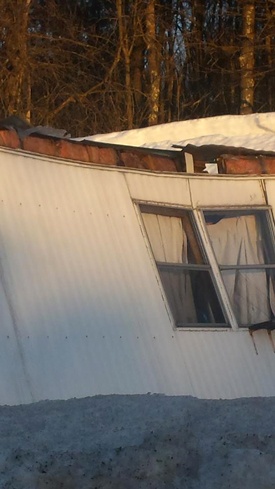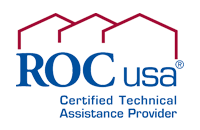
How to prevent and remove ice dams
By Chris Clasby
Ice dams can create havoc with your roof. Here's are some practical tips that stop them cold.
Another New Hampshire winter is finally upon us. We’ve been lucky so far, with just a few small snow storms and one big storm that missed us. But winter is far from over, and it’s time to think about ice dams, the damage they can inflict upon our homes, and how to prevent them from forming.
The experts tell us proper insulation and ventilation in the area between the ceilings and roofs of our homes will prevent ice dams. That may be true in milder winter climates south of the New Hampshire border, but the reality of our winters and of living in a manufactured home is that ice dams are a common occurrence.
 |
|
Manufactured home badly damaged by ice dams. |
Oftentimes, the shallow roof pitch of most manufactured homes means snow won’t slide off a metal roof. And as some of us are painfully aware, ice dams will form on them or on metal ice guards placed at the eaves of a home.
If you’re a do-it-yourselfer, either by choice or financial necessity, winter means you have to break out the roof rake. The best advice I’ve found is to take care of this chore as soon as snow starts to collect on the roof.
Clearing four or five feet from the edge of the eaves will do the trick when temperatures are reasonable. By doing this, ice dams don’t get a chance to form and you don’t give the sun and any heat radiating from the roof below a chance to turn the snow into a wet, heavy mess that will make this chore a back-breaking, arm-burning workout fit for a professional bodybuilder.
However, when temperatures are cold enough that ice dams start to form further up the roof (where the snow hasn’t been cleared), it’s time to haul the rake out again to clear that entire side of the roof.
Since roof rakes are long, efficient, electrical conductors leading directly to your hands, always be mindful of any overhead electrical lines where you are working.
If you are going to hire a contractor to clear your roof, hire someone who is qualified to do the work and is properly insured. This work has a high risk of injury or property damage; if your contractor isn’t insured, those costs will fall to you or your homeowner’s insurance. I suggest asking your insurance agent for the types and amounts of coverage you should require from your contractor.
If ice dams have formed and are leaking or threaten to leak into your home, they must be removed. The best contractors are now using steam to remove ice dams. It’s effective, and reduces the risk of roof damage.
If you must try to remove or cut a channel in an ice dam yourself in order to stop water from leaking into your home, hot water is your best option. Cold water from your outside spigot will work, but very slowly. When I haven’t followed my own advice and an ice dam has formed, I run a garden hose from my washing machine’s hot water supply. If the garden hose comes out of the shed plugged with ice, putting it in the bathtub under hot water can be quicker than trying to locate and thaw the frozen section.
Again, if you must do this work yourself, here are some practical tips from years of battling ice dams:
- Slow down. Yes, water is leaking into your home. But it will stop sooner if the job is done as safely as possible, and will almost certainly continue if you injure yourself.
- Remove as much snow as possible above the ice dam.
- Practice good ladder safety. Prepare for snow and ice to get under foot−yours and the ladder’s. Don’t find yourself atop a wooden ladder with round wooden rungs when it does. A stepladder is a safer option if you have to set up on a deck, patio, or other surface that will become slippery once the work begins.
- When applying hot water, position yourself and your ladder off to the side to minimize the amount of water that will refreeze on your ladder rungs and under your feet.
- Don’t use blow torches, hair dryers or heat guns. They’re ineffective and can be dangerous.
- Resist the temptation to swing hatchets or mallets. They’ll break up ice dams at the right temperatures, but there’s a good chance you’ll damage your roof.
That’s my list, but there’s plenty more good advice online, including the benefits and pitfalls of each approach. A Web search for “ice dams” will get you started.
Chris Clasby is a Credit and Portfolio Analyst for ROC-NH™.
ROC-NH™ is a program of the New Hampshire Community Loan Fund, Inc. and a ROC USA® Certified Technical Assistance Provider.
ROC-NH is a registered service mark of ROC USA, LLC.















